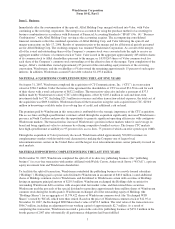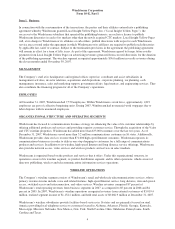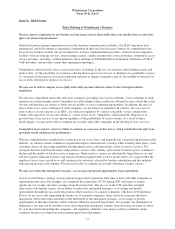Windstream 2007 Annual Report Download - page 53
Download and view the complete annual report
Please find page 53 of the 2007 Windstream annual report below. You can navigate through the pages in the report by either clicking on the pages listed below, or by using the keyword search tool below to find specific information within the annual report.
Windstream Corporation
Form 10-K, Part I
Item 1. Business
Although high-speed Internet services have been a source of revenue and customer growth for Windstream, that service
offering experiences competition from other high-speed Internet service providers, including cable television and
satellite transmission service providers. As further discussed below under the caption “Federal Regulation – High-
Speed Internet Services”, the FCC in 2005 concluded that high-speed Internet services were an “information service”.
As a result, the FCC provided price-cap companies the option to deregulate, and rate-of-return companies the option to
de-tariff, high-speed Internet services. In addition, a number of carriers have begun offering voice telecommunications
services utilizing the Internet as a means of transmitting those calls. This service, commonly known as VoIP telephony,
is challenging existing regulatory definitions. As further discussed below under the caption “Federal Regulation – VoIP
Telephony”, on March 10, 2004, the FCC adopted a Notice of Proposed Rulemaking that considered the appropriate
regulatory treatment of IP-enabled communications services. Even though the FCC has not yet determined the
regulatory treatment for IP-enabled services, it has required VoIP providers terminating or receiving calls from
the public switched network to comply with several regulatory requirements. The results of the FCC’s proceedings
related to VoIP could have a significant effect on Windstream’s wireline operations.
REGULATION
Our incumbent local exchange carrier subsidiaries (collectively the “ILECs”) are regulated by both federal and state
agencies. Our interstate products and services and the related earnings are subject to federal regulation by the FCC and
our local and intrastate products and services and the related earnings are subject to regulation by state Public Service
Commissions (“PSCs”). The FCC has principal jurisdiction over interstate switched and special access rates, as well as
high-speed Internet service offerings. It also regulates the rates that ILECs may charge for the use of their local
networks in originating or terminating interstate and international transmissions. The PSCs have principal jurisdiction
over matters including local service rates, intrastate access rates, quality of service, the disposition of public utility
property and the issuance of securities or debt by the local operating companies. As a regulated entity, the Company is
required to comply with various federal and state regulations. The Company believes it is in compliance in all material
respects with all federal and state regulations and requirements.
FEDERAL REGULATION
Communications services providers are regulated differently depending primarily upon the network technology used to
deliver the service. This patchwork regulatory approach advantages certain companies and disadvantages others. It
impedes market-based competition where service providers using different technologies exchange telecommunications
traffic and compete for customers.
From time to time federal legislation is introduced dealing with various matters that could affect our business.
Currently, three bills addressing comprehensive universal service reform have been introduced and are being discussed
in Congressional committees. Most proposed legislation of this type never becomes law. It is difficult to predict what
kind of reform efforts, if any, may be introduced in Congress and ultimately become law. Windstream strongly
supports the modernization of the nation’s telecommunications laws, but at this time, cannot predict the timing and the
resulting financial impact of any possible federal legislative efforts.
Conversion to Price Cap Regulation
With the exception of our Nebraska and New Mexico operations, and a portion of our Kentucky, Oklahoma and Texas
operations (collectively the “price cap subsidiaries”), our interstate ILEC operations, consisting primarily of network
access services, are subject to rate-of-return regulation by the FCC. Under rate-of-return regulation, interstate rates are
established based on forecasted investment and expenses plus a prescribed return on investment, currently set at 11.25
percent. The price cap subsidiaries are subject to price cap regulation by the FCC. Under price cap regulation, interstate
rates are not established in direct relation to forecasted investment and expense, but are subject to adjustment annually
based on economic indices such as the consumer price index. Companies meeting certain criteria had the option to elect
price cap regulation for interstate services as part of an FCC order issued in May 2000 (the “CALLS plan”). The
CALLS plan expired on June 30, 2005, and to date, the FCC has not established a successor mechanism for regulating
price cap companies. Nonetheless, the CALLS plan remains in effect until the FCC modifies or otherwise replaces it.
On August 7, 2007, Windstream filed a petition with the FCC to convert the majority of its remaining interstate
rate-of-return regulated operations to price cap regulation. Under price cap regulation, high-speed Internet services can
7
























